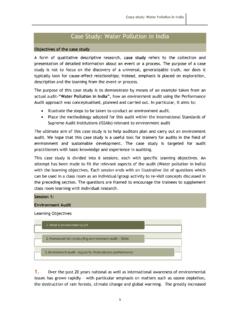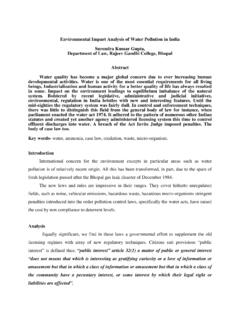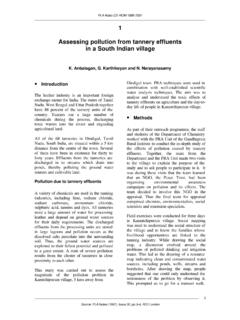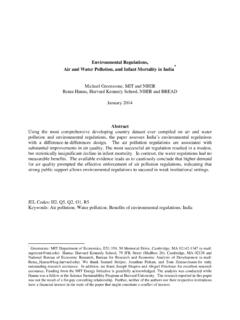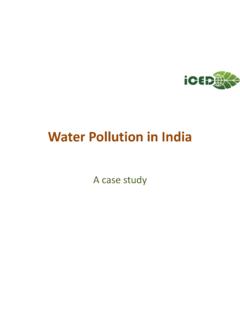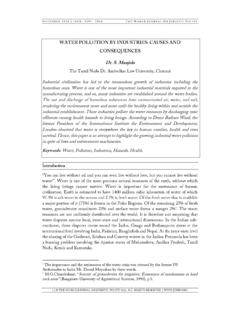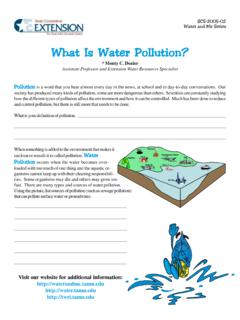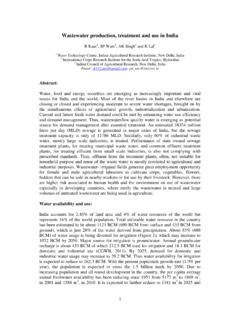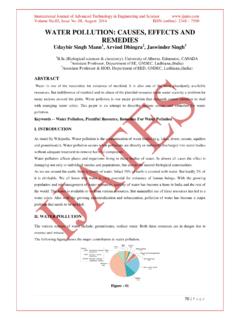Transcription of Environmental Regulations, Air and Water Pollution, and ...
1 Michael GreenstoneMassachusetts Institute of TechnologyRema HannaHarvard Kennedy SchoolEnvironmental regulations , Air and Water pollution , and Infant Mortality in india September 2012 Discussion Paper Environmental Economics ProgramDEVELOPING INNOVATIVE ANSWERS TO TODAY S COMPLEX Environmental CHALLENGES Environmental regulations , Air and Water pollution , and Infant Mortality in india Michael Greenstone Massachusetts Institute of Technology Rema Hanna Harvard Kennedy School The Harvard Environmental Economics Program The Harvard Environmental Economics Program (HEEP) develops innovative answers to today s complex Environmental issues, by providing a venue to bring together faculty and graduate students from across Harvard University engaged in research, teaching, and outreach in Environmental and natural resource economics and related public policy.
2 The program sponsors research projects, convenes workshops, and supports graduate education to further understanding of critical issues in Environmental , natural resource, and energy economics and policy around the world. Acknowledgments The Enel Endowment for Environmental Economics at Harvard University provides major support for HEEP. The Endowment was established in February 2007 by a generous capital gift from Enel SpA, a progressive Italian corporation involved in energy production worldwide. HEEP receives additional support from the affiliated Enel Foundation. HEEP is also funded by grants from the Alfred P. Sloan Foundation, the James M. and Cathleen D. Stone Foundation, Chevron Services Company, Duke Energy Corporation, and Shell. HEEP enjoys an institutional home in and support from the Mossavar-Rahmani Center for Business and Government at the Harvard Kennedy School.
3 HEEP collaborates closely with the Harvard University Center for the Environment (HUCE). The Center has provided generous material support, and a number of HUCE s Environmental Fellows and Visiting Scholars have made intellectual contributions to HEEP. HEEP and the closely-affiliated Harvard Project on Climate Agreements are grateful for additional support from the Belfer Center for Science and International Affairs at the Harvard Kennedy School, ClimateWorks Foundation, the Qatar National Food Security Programme, and Christopher P. Kaneb (Harvard AB 1990). Citation Information Greenstone, Michael, and Rema Hanna. Environmental regulations , Air and Water pollution , and Infant Mortality in india , Discussion Paper 2012-40, Cambridge, Mass.: Harvard Environmental Economics Program, September 2012.
4 The views expressed in the Harvard Environmental Economics Program Discussion Paper Series are those of the author(s) and do not necessarily reflect those of the Harvard Kennedy School or of Harvard University. Discussion Papers have not undergone formal review and approval. Such papers are included in this series to elicit feedback and to encourage debate on important public policy challenges. Copyright belongs to the author(s). Papers may be downloaded for personal use only. Environmental regulations , AIR AND Water pollution , AND INFANT MORTALITY in india Michael Greenstone Rema Hanna ABSTRACT Using the most comprehensive data file ever compiled on air pollution , Water pollution , Environmental regulations , and infant mortality from a developing country, the paper examines the effectiveness of india s Environmental regulations .
5 The air pollution regulations were effective at reducing ambient concentrations of particulate matter, sulfur dioxide, and nitrogen dioxide. The most successful air pollution regulation is associated with a modest and statistically insignificant decline in infant mortality. However, the Water pollution regulations had no observable effect. Overall, these results contradict the conventional wisdom that Environmental quality is a deterministic function of income and underscore the role of institutions and politics. Michael Greenstone Rema Hanna MIT Department of Economics Kennedy School of Government 50 Memorial Drive, E52-359 Harvard University Cambridge, MA 02142-1347 79 JFK Street and NBER Cambridge.
6 MA 02138 and NBER We thank Samuel Stolper for truly outstanding research assistance. In addition, we thank Joseph Shapiro and Abigail Friedman for excellent research assistance. Funding from the MIT Energy Initiative is gratefully acknowledged. The analysis was conducted while Hanna was a fellow at the Science Sustainability Program at Harvard University. 2011 by Michael Greenstone and Rema Hanna. All rights reserved. Short sections of text, not to exceed two paragraphs, may be quoted without explicit permission provided that full credit, including notice, is given to the source. 2 I. INTRODUCTION There is a paucity of evidence about the efficacy of Environmental regulation in developing countries.
7 However, this question is important for at least two First, "local" pollutant concentrations are exceedingly high in many developing countries and they impose substantial health costs, including shortened lives (Chen, Ebenstein, Greenstone, and Li 2011). Thus, understanding the most efficient ways to reduce local pollution could significantly improve wellbeing in developing countries. Second, the Copenhagen Accord makes it clear that it is up to individual countries to devise and enforce the regulations necessary to achieve their national commitments to combat global warming by reducing greenhouse gas emissions. Since most of the growth in greenhouse gas (GHG) emissions is projected to occur in developing countries, such as india and China, the planet's wellbeing rests on the ability of these countries to successfully enact and enforce Environmental regulations .
8 india provides a compelling setting to explore the efficacy of Environmental regulations in a developing country for several reasons. First, india 's population of nearly billion accounts for about 17 percent of the planet's population. Second, the country is experiencing rapid economic growth of about percent annually over the last two decades, which is placing significant pressure on the environment. For example, Figure 1, Panel A demonstrates that ambient particulate matter concentrations in india are five times the level of concentrations in the United States (while China's are seven times the level) in the most recent years with comparable data, while Figure 1, Panel B shows that Water pollution concentrations in india are 1 There is a large literature measuring the impact of Environmental regulations on air quality, with many of them finding that significant regulation-induced reductions in pollution concentrations in the United States.
9 See, for example, Chay and Greenstone (2003 and 2005), Greenstone (2003), Greenstone (2004), Henderson (1996), Hanna and Oliva (2010), and so forth. However, given the institutional differences that exist between the United States and many developing countries, it is not clear that knowledge on what works in the United States is necessarily relevant in other contexts. 3 also higher. Third, india has a surprisingly rich history of Environmental regulations that dates back to the 1970s, providing a rare opportunity to answer these questions with extensive panel Finally, india remains below the income levels at which the Environmental Kuznets curve literature predicts that pollution concentrations turn downward ( , Grossman and Krueger, 1995; Shafik and Bandyopadhyay, 1992; Selden and Song, 1994; Stern and Common, 2001; Copland and Taylor, 2004), implying that it is at a stage of development where economic growth trumps Environmental concerns.
10 Consequently, taking the predictions of these models at face value, it may be reasonable to expect that most of the Environmental policies implemented to date have been ineffective. This paper presents a systematic evaluation of india s Environmental regulations . The analysis is conducted with a new city-level panel data file for the years 1986-2007 that we constructed from data on air pollution , Water pollution , Environmental regulations , and infant mortality in india . The air pollution data cover about 140 cities, while the Water pollution data comprises information from 424 cities (162 rivers). Neither the government nor other researchers have ever assembled a city-level panel database of india 's anti- pollution laws. Furthermore, we are unaware of a comparable data set in any other developing country.

